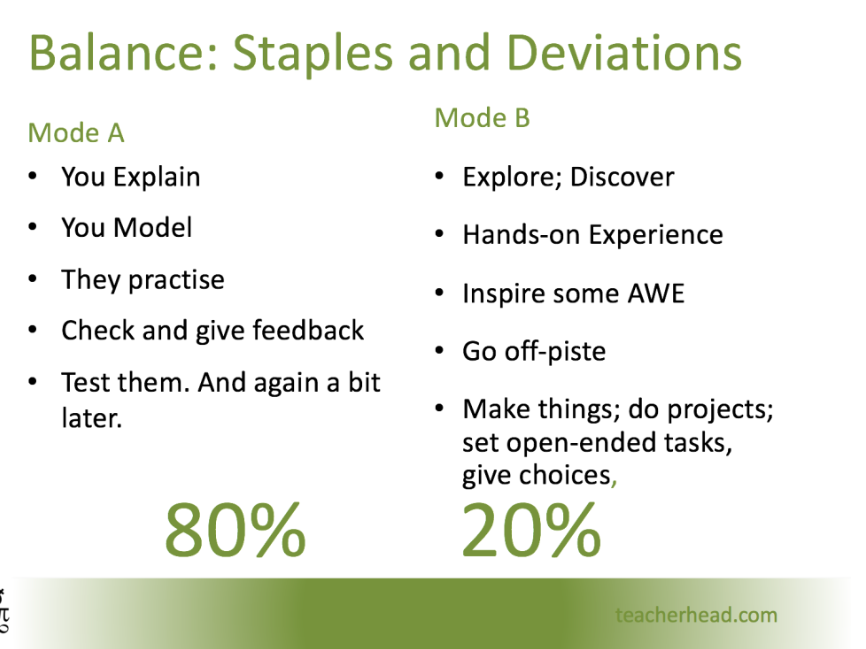1 May 2022

|
Whole School CPD Focus: |
Oracy for Writing |
|
Walkthru Cluster: |
Mode B Teaching
|
|
Walkthru: |
Oracy: Instructional Inputs
|
|
Reflections… Sherrington’s blog outlines the distinction between Mode A and Mode B teaching above and also – as a physics teacher – how he sees his breakdown of time. When talking about Mode B teaching, Sherrington says, ’I can’t imagine a truly great curriculum where students do not, at some point, have a range of hands-on experiences, learn to make choices, explore ideas independently to find patterns and rules or develop original ideas’. Mode A teaching, quite rightly, has been the focus of our CPD (and indeed our Walkthru focus) over the course of the last year; however, Mode B teaching is also essential to allows students to work independently and in a different way.
In Shimamura’s MARGE model (explanation attached), he suggests that engaging students in a process where they ‘Think it, say it, teach it!’ can lead to significant gains for long-term recall. In terms of personal development, it is also a positive experience for students as they address their peers to explain a concept or a problem. Having students prepare a set of instructions or explanatory step can be challenging in terms of language and speech. Sherrington suggests that lessons can be organised to give all students this opportunity over time.
So, what are the five steps for embedding this Walkthru?
Stage one: identify material for students to explain Identify either: specific questions or problems for then to present model solutions to. Remember, students will need to have sufficient knowledge to do this in advance of the lesson. OR, identify a concept or piece of instructional input for students to explain without too much support. For example:
Stage two: allocate instructional tasks Give each individual or pair of students a specific concept or question. Give them a specific date on which they will present their instructional input. Walkthrough the timeframe and the content provided and ensure that they have what they need to prepare. Where necessary, provide guidance on the process (i.e. not reading from PPT slides; include a diagram; offer a physical demonstration, etc).
Stage three: invite students to rehearse and present material Provide students the opportunity to practise their input in class or as a homework activity. When ready, ask students to address the class with their material. They should stand at the back of the room, project their voices, make eye contact with their audience and not look at the board. At this point, the teacher will provide guidance whilst also keeping the class on track and listening to their classmate’s input.
Stage four: include tasks for the rest of the class Good instructional input will become a mini-lesson. Presenters should be encouraged to design tasks for their class to show that they are understanding their ‘mini lesson’. This could be practice questions, problems, writing tasks or discussion tasks. By clarifying this in advance, the audience will know that they have to pay attention.
Stage five: Check for recall and understanding Encourage your selected ‘student teachers’ to engage the class in Check for Understanding techniques using questioning or quizzing techniques. They may also use mini-whiteboards to ask questions to ensure everyone is following. The teacher is not redundant throughout this process. Throughout, support the student teachers, correct any misconceptions add in any input and check for understanding.
Clearly, activities like this are time consuming and would need to be planned across a period of time. You could plan for all students do this throughout the course of a term, for example. However, by empowering students in this way and allowing them to take responsibility for their learning they are forced to grapple with the material and to ensure that they explore the best way to learn it: surely this is worth a try.
Previous blogs and Walkthrus in this cluster:
|
|
|
CPD Cascade |
National CollegeRemember that there are subject-specific watchlists available in National College.
|
Posted by Rachel Long
Category: Teaching and Learning Digests
